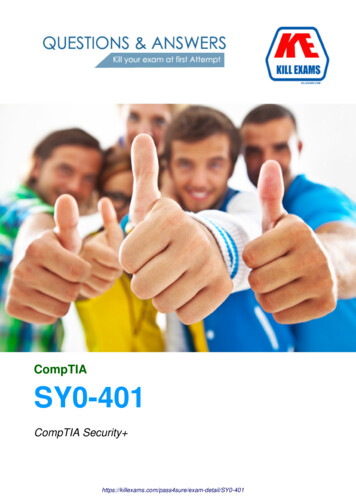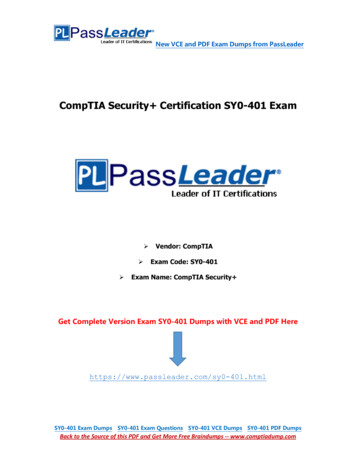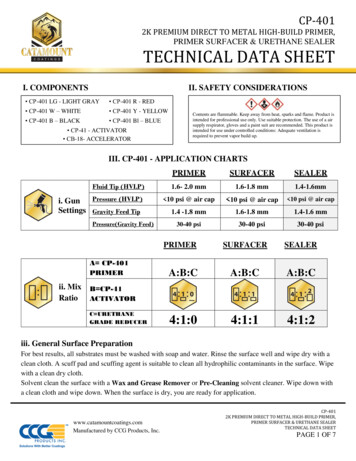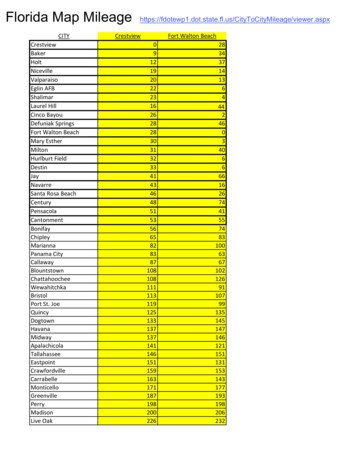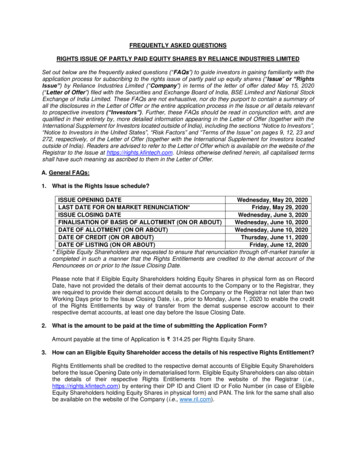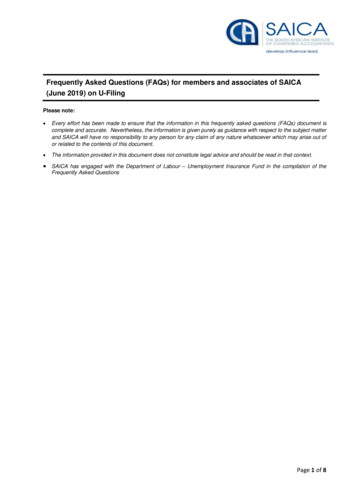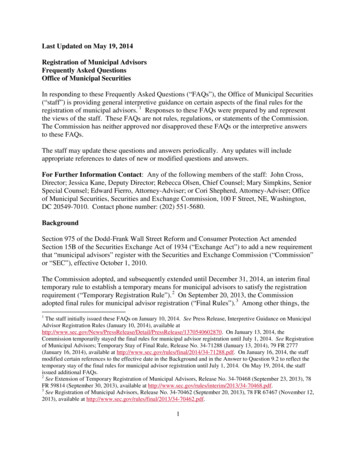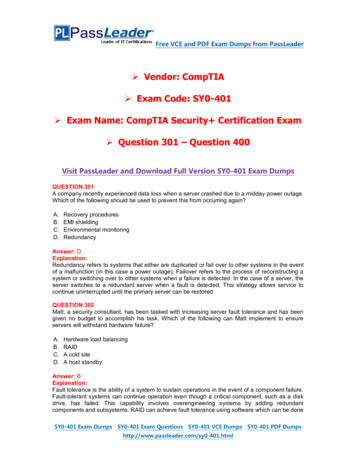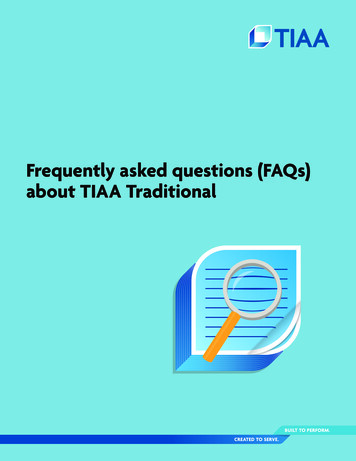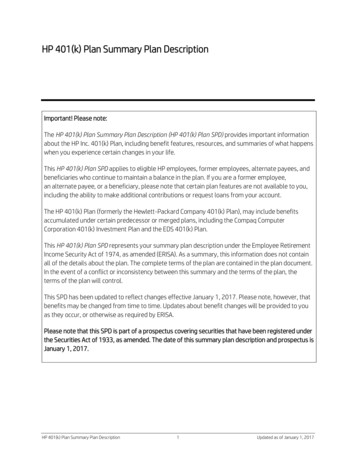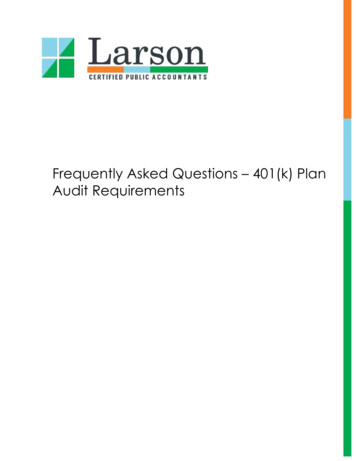
Transcription
Frequently Asked Questions – 401(k) PlanAudit Requirements
Why does the plan need an audit?The Department of Labor (DOL) to be exact. For 401(k) plans (and 403(b) plans) that have 100or more active eligible participants at the beginning of the plan year (usually January 1), theDepartment of Labor (DOL) requires that an audit report and the plan’s audited financialstatements be attached when filing the annual form 5500. There are exceptions for plans in thefirst year that they meet the 100 active eligible participant threshold, so it’s best to have a qualifiedCPA firm help make the call on whether an audit is required.When is a 401(k) plan required to be audited?An audit is required to be performed by a qualified third party CPA firm when certain conditionsare met, primarily when total eligible participants reach 100 and the plan is deemed a "large"plan, plans that are required to file Schedule H with 5500. See the decision tree below to assistin determining if an audit will be required.How do I find the number of eligible participants?Check your 401 (k) Form 5500 as filed Part II line 6.Who is a participant for purposes of these counts?The number of participants is counted on the first day of the plan year. You must count allemployees who are eligible to participate when counting participants in an employee benefitpension plan, whether or not they actually choose to do participate. (The rules are different forwelfare benefit plans). You must also count all separated participants with account balances or adeferred, vested balance. Because the number of participants is counted on the first day of theplan year, not on the last day of the previous plan year, these numbers may be different if the firstday of the plan year is an entry date for the plan.
Are there any exceptions to the audit requirements?Yes, there is an exception to these audit requirements. Short Plan Year - If the Plan would qualifyas a large Plan, and its Plan year is seven months or less, the Plan sponsor may elect to deferthe audit requirement to the following Plan year. In the following year, the Plan sponsor will berequired to have the plan audited for the short Plan year if the Plan qualifies as a small Plan.I need an audit, what comes next?First, you will need to determine what type of audit you need - a limited scope audit or a full scopeaudit.What is the difference between a limited scope and a full scope audit?A limited scope audit allows a plan to have an audit where the auditor may rely on the certificationof an institutional trustee or custodian to limit the scope of testing on any investment information.The limited scope exception only applies to investments, therefore, you should expect that yourauditors will still conduct procedures in all other audit areas. For a full scope audit proceduresover investments will not be limited and there is not a certification to rely on.The Plan may qualify to have a limited scope audit if all or a part of the Plan's assets are held bya bank, insurance company or regulated trust company. The asset custodian or trustee must besubject to regulation by a state or federal agency and able to provide to the Plan sponsor thecertification required under Department of Labor regulations 2520.103-8. See the flow diagrambelow to help determine whether you need a full or limited scope audit.
What if my plan has only some of the assets held with a custodian that can provide a certification?The auditor may perform limited scope audit procedures for the assets held at the certifyinginstitution, but must perform full scope audit procedures for the other assets.How will the auditor's report read if we have a limited scope audit?The auditor's report will disclaim an opinion due to the significance of the information that they didnot audit. A disclaimer under these regulations is acceptable to the Department of Labor, and isa common, standard report that informed parties who understand the reporting requirements arefamiliar with.What is the Employee Benefit Plan Audit Quality Center (EBPAQC) and why does it matter?The EBPAQC is a voluntary membership organization for firms performing ERISA employeebenefit plan audits. Its purpose is to promote the quality of employee benefit plan audits. TheEBPAQC provides members with timely communication of regulatory updates, best practicesguidance, technical updates and member to member discussion forums.Why should I look for an audit firm that is a member of the EBPAQC?Studies by the Department of Labor of employee benefit plan audits show a much smallerdeficiency rate in firms that belong to the EBPAQC than those that do not. This is a verysignificant factor to consider, given the fiduciary responsibility of the plan sponsor to have aquality audit performed.What is the audit filing deadline?The audit report must be attached to the Form 5500, so it is subject to 5500 filing deadlines. The5500 is due seven months after the last day of the plan year, but may be extended for anadditional two and a half months.How much time should I allow to complete the audit?It is best to begin the audit at least two to three months prior to the due date, to allow time to planthe audit, gather information, receive responses to all confirmation requests, perform fieldwork,follow up on open items, draft financial statements and wrap up the audit. Adequate time shouldbe left to address and resolve unforeseen problems prior to the filing deadline. However, if youhave just realized you have an audit requirement and the timing is tighter than this, we arespecialists in performing audits under deadline and will make every effort to meet yours. If youare having an audit performed for the first time it often takes longer to get required documentsfrom various sources, sometimes more than a month.Who pays for the plan audit?The fees of the 401(k) plan audit are plan expenses, meaning that the plan is responsible to bearthe cost of the audit, not the company (sponsor). While it is a noble cause for the sponsor to payfor the audit of the plan, it is not required. There is a fiduciary duty to minimize plan expenses, buta sponsor should always consider using plan assets to pay for plan expenses. The plan documentshould state who is responsible to pay for the audit of the plan.
CONTACT LARSON & COMPANYDiane Nesbit, CPADNESBIT@LARSCO.COM801-313-19009065 South 1300 EastSalt Lake City, UT 84094
The Department of Labor (DOL) to be exact. For 401(k) plans (and 403(b) plans) that have 100 or more active eligible participants at the beginning of the plan year (usually January 1), the . The fees of the 401(k) plan audit are plan expenses, meaning that the plan is responsible to bear the cost of the audit, not the company (sponsor). While .
